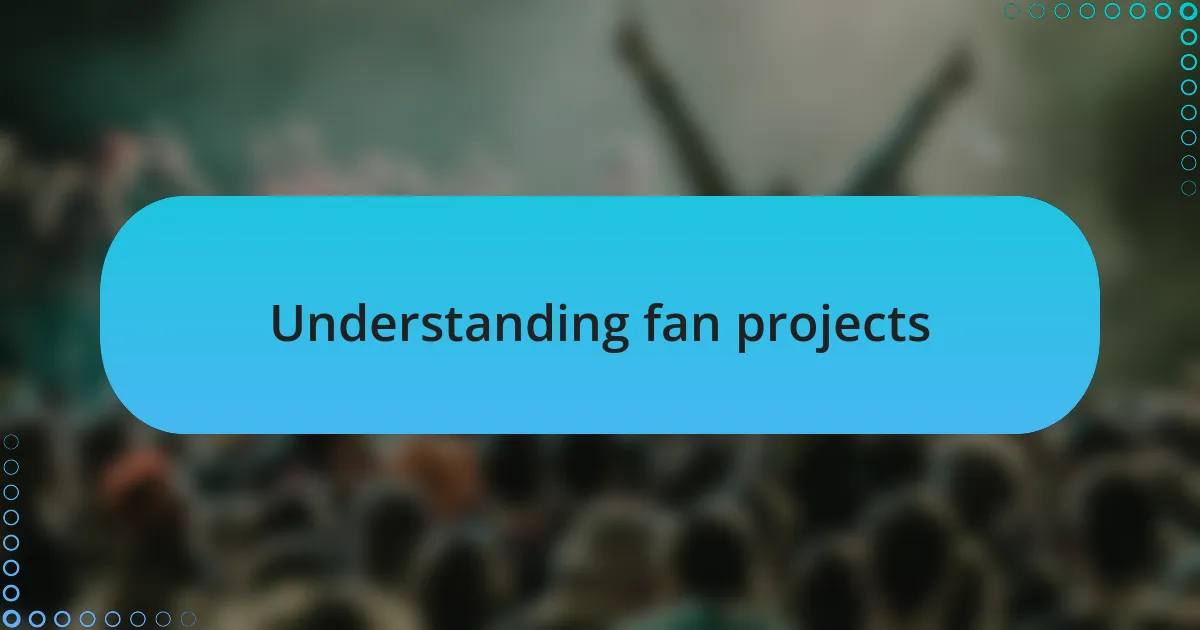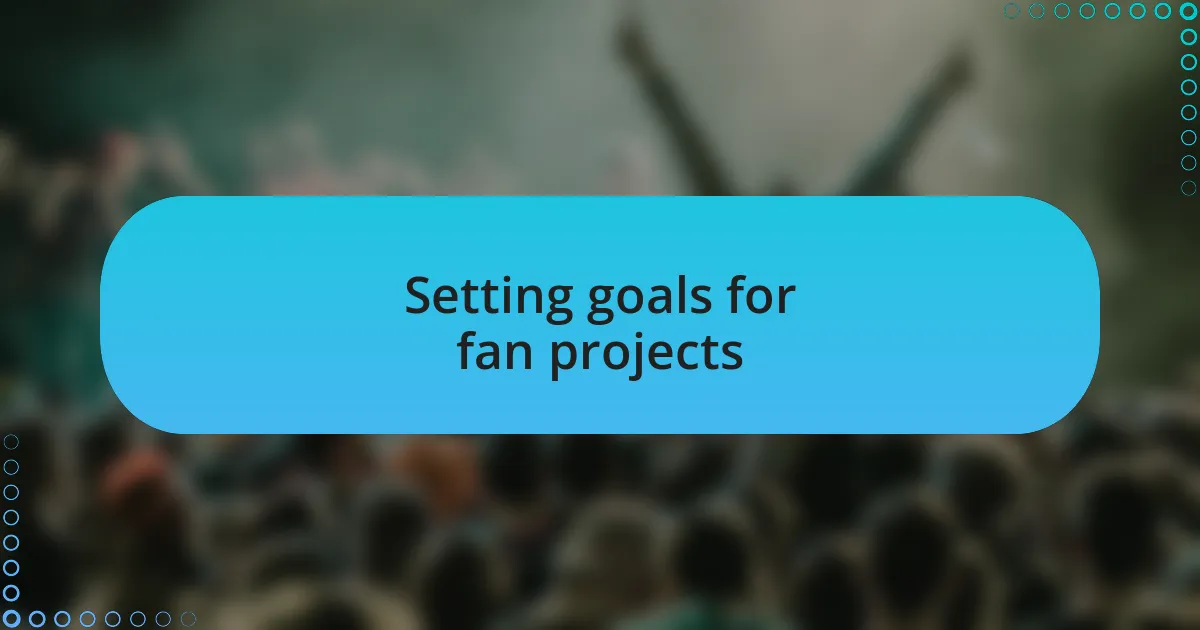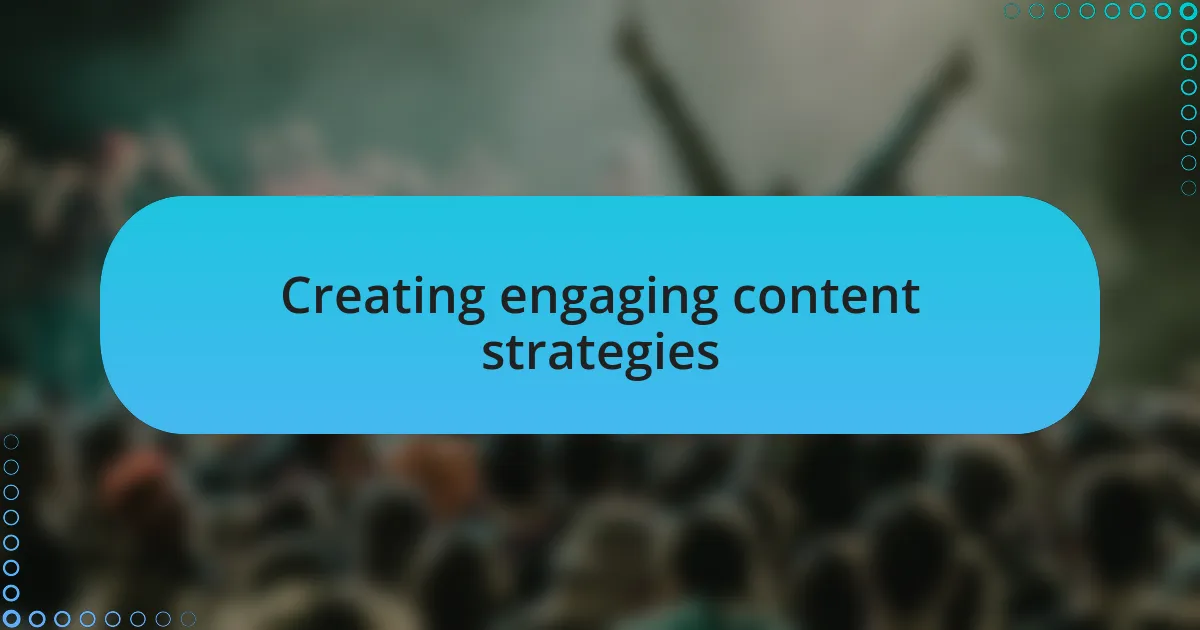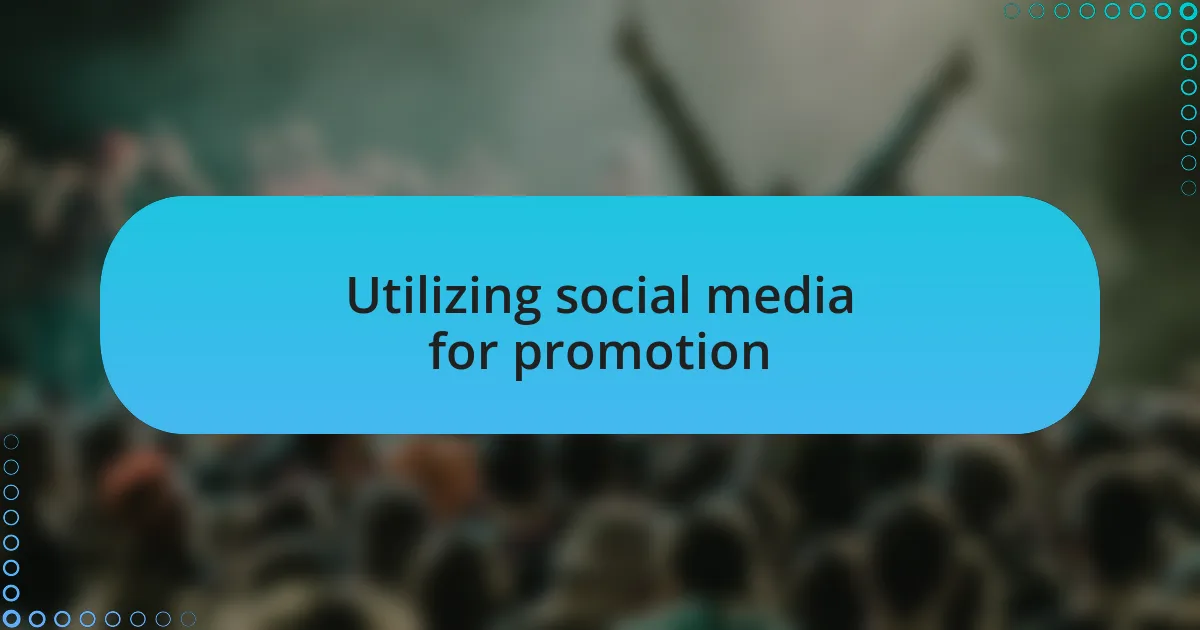Key takeaways:
- Fan projects foster community and creativity, allowing fans to express their passion through diverse formats like art, videos, and music remixes.
- Setting clear goals for fan projects enhances focus and can lead to unexpected collaborations and deeper community connections.
- Engaging content strategies, such as storytelling and interactive formats, stimulate community dialogue and strengthen fan relationships.
- Evaluating projects involves understanding emotional responses and gathering feedback to adapt and improve future initiatives.

Understanding fan projects
Fan projects can vary widely in scope and creativity, reflecting the unique passions of the fans behind them. I remember the first time I stumbled upon a fan-made documentary about my favorite band. It gave me chills to see how deeply these fans delved into the band’s history, showcasing their love and dedication. Have you ever watched a fan project that resonated with you in such a way?
At their core, fan projects represent a community-driven effort to celebrate and expand the narrative of a beloved band. They can take many forms—art, stories, videos, or even music remixes. I often wonder what drives fans to dedicate so much time and energy to these projects. For me, it’s the sheer joy of collaboration and exploration that fuels my involvement in these endeavors.
The emotional connection that fans have with their favorite artists often translates directly into their projects. I’ve seen how a simple album cover redesign can spark conversations and lead to deep interpretations of song lyrics. In a world dominated by commercial interests, isn’t it refreshing to see passion take center stage?

Setting goals for fan projects
Setting clear goals for fan projects is crucial for direction and focus. I recall launching a project to create a tribute album for a lesser-known band, and my initial goal was simply to connect with other fans. This clarity ignited our creativity and led to a collaborative effort that exceeded my expectations; we ended up releasing something that truly honored the band’s legacy.
When establishing goals, it’s essential to consider the impact you want your project to have on the community. For instance, while working on a fan art compilation, I aimed to inspire artists by providing a platform to showcase their talent. To my surprise, this led to friendships and collaborations that just wouldn’t have happened otherwise; it’s amazing how a shared vision can unite people.
I’ve learned that goals can evolve as the project progresses. Initially, I wanted to produce a simple video montage, but as I gathered more fan contributions, the project transformed into a more ambitious documentary. Isn’t it fascinating to see how your initial intentions can shift as creativity flourishes? This adaptability not only enriches the project but also deepens the connections within our fan community.

Creating engaging content strategies
Creating engaging content requires a thoughtful approach that resonates with your audience. In my experience, I’ve found that storytelling is one of the most powerful tools. When I decided to curate a series of blog posts about my favorite band’s history, I didn’t just list facts; I shared personal reflections and memories tied to their music. This not only captured attention but also drew fellow fans into a shared narrative, prompting lively discussions.
Another strategy I’ve embraced is diversifying content formats. For example, while preparing a fan video project, I included fan interviews, behind-the-scenes footage, and even a few live performance clips. Each piece not only showcased different aspects of the band but also encouraged fans to engage from multiple angles. Have you ever noticed how a single photograph or a snippet of a live performance can reignite a wave of nostalgia? It’s these varied formats that keep the content fresh and exciting for everyone involved.
Moreover, engaging content often thrives on interaction. I once hosted a live Q&A session with fans following a major release. The energy during that session was palpable; fans shared their thoughts and theories about the band, creating a community dialogue that deepened everyone’s appreciation for the music. The tangible connection formed through real-time interaction is something I treasure, and it reinforces the idea that fan projects shouldn’t just be about broadcasting content but fostering community engagement.

Utilizing social media for promotion
Social media is an incredible tool for promoting fan projects, and I’ve had my fair share of success tapping into its potential. When I created a dedicated Instagram account for my fan project, I started posting snippets and visuals that celebrated my favorite band. There’s something exhilarating about watching follower counts climb while seeing fans share my posts with their own communities. It’s as if every like and repost is a small affirmation that we’re all connected through our mutual love for the music.
Engaging with fans on social media offers unique opportunities to spur discussions that can elevate the excitement surrounding a project. For instance, I once launched a Twitter poll asking fans to vote for their favorite album cover by my band. The responses came flooding in, and the conversations spiraled into deep dives about the meanings behind the artwork. Have you ever seen how a simple question can ignite a wave of nostalgic reminiscence? It took mere seconds to set up but resulted in a vibrant discourse that bound us even closer together as fans.
Additionally, I’ve found that leveraging live-streaming features can be a game changer. I remember hosting a Facebook Live event to unveil a fan remix I created, and the anticipation was palpable. Watching fans react and comment in real-time as I shared the track was invigorating; it reinforced the idea that our shared passion thrives not just in listening to music, but in celebrating it together. In this digital landscape, creating spaces for interaction is paramount, and I believe it’s these moments that transform casual fans into an engaged community.

Managing community interactions
Managing community interactions is crucial for fostering a vibrant fan base. I often find that simply responding to comments can make a world of difference. For instance, during a recent Q&A session on my fan project’s forum, one fan expressed their struggle connecting with others over our shared interests. I took the time to engage in a heartfelt conversation with them, and the joy in their response reminded me how important it is to create a safe space where everyone feels valued. Have you ever considered how a small gesture could spark lasting friendships among fans?
In addition to direct engagement, I believe establishing regular community events can sustain interest and interaction. When I organized a themed discussion night around our favorite band’s lyrics, the enthusiasm was infectious. Fans shared personal stories about how certain songs mirrored their life experiences. This mutual exchange not only deepened our connections but also reminded me of the powerful role music plays in our lives. Isn’t it amazing how a shared melody can become the backdrop of our own stories?
Lastly, creating a newsletter or updates that spotlight community members can drive engagement too. I recently featured a talented fan artist in my newsletter, showcasing their illustrations inspired by our beloved band. The response was overwhelmingly positive, with numerous fans reaching out to express their appreciation for the artist’s work. This not only validated the artist’s talent but also reinforced a sense of belonging within our community. How do you highlight the incredible contributions of fans in your own projects? I believe acknowledging their efforts amplifies their engagement and strengthens community bonds.

Evaluating project success and feedback
When evaluating project success, I’ve learned that it’s essential to measure not just outcomes but also the feelings behind them. For instance, after launching a new fan art competition, I encouraged participants to share their emotional journeys alongside their artwork. The outpouring of creativity and personal stories from fans revealed not only their talent but also the deep connections they had to our shared passion. It reaffirmed what I often suspect: that success isn’t just about numbers; it’s about the bonds we cultivate.
Feedback is a treasure trove, and I always make it a priority to gather it after any major event. Following a virtual concert I organized, I sent out a quick survey asking fans how they felt about the experience. One response struck me deeply: a fan mentioned that the concert helped distract them from a tough time in their life. That insight made all the effort worthwhile and highlighted the importance of truly understanding the impact our projects have. How do you ensure you’re tapping into the emotional layer of feedback in your own initiatives?
I also believe in creating an open dialogue about what worked and what didn’t. After our last community project, I set up a discussion thread inviting fans to discuss their thoughts candidly. The honesty shared in those conversations was invaluable. Someone mentioned how they felt overwhelmed by certain aspects, which spurred me to rethink our approach. It reminded me that to grow, we must listen and adapt. Isn’t it fascinating how each piece of feedback can shape the future of our projects?